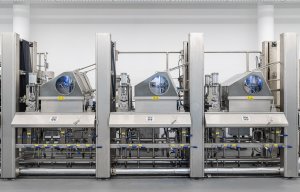
Karl Mayer partners with leading denim brands
Thanks to the NOX reactor, the Greendye system requires only three dyeing baths instead of nine – as with conventional systems – to achieve the same indigo dye shade.

6th July 2022
Innovation in Textiles
|
Taiwan
In 2019, Karl Mayer Rotal introduced Greendye, a technology that offers both sustainability and at the same time more economic efficiency than conventional plants for the indigo dyeing of denim fabrics. Later this year, Nien Hsing of Taiwan is installing the first of these new systems to improve its eco-balance in warp preparation.
“We got to know the pilot plant at Karl Mayer Rotal and studied its operation in detail in terms of output, costs and sustainability and the results convinced us,” says chairman Chen Chao Kuo.
With Greendye, indigo dyeing is twice as clean and at the same time three times more efficient than with conventional equipment as a result of the use of nitrogen (NOX) technology to control the chemical dyeing process, the machine builder says.
A nitrogen atmosphere temporarily prevents the necessary oxidation of indigo dye. In the NOX reactor, the indigo dye has time to create a more solid physical bond into the fibre composite, adhere there and be fixed. It is also possible to increase the indigo concentration in the dye bath.
These effects enable the yarn to absorb three times more dye than with conventional processes.
Further advantages result from the design of the dyeing vats. A high-flow, low-speed indigo circulation system and a design that avoids turbulence and surface foaming significantly reduce chemical consumption. The result is a saving of up to 50% of hydrosulphite and caustic soda – the main environmental polluters of the process.
A reduction of 50% is also possible in the final washing water consumption. Thanks to the NOX reactor, the Greendye system requires only three dyeing baths instead of nine – as with conventional systems – to achieve the same indigo dye shade with correspondingly lower water consumption. In addition, the washing process is more economical due to the higher fixation of the indigo dye on the fibre.
Fewer dyeing baths also mean shorter dyeing sections. The difference in length is two-thirds and reduces the amount of yarn waste.
The reduction of daily water and chemical consumption as well as waste water and yarn waste optimises not only the environmental balance but also the production costs of indigo dyeing. Compared to traditional indigo dyeing systems, the system requires less space due to its shorter design, less maintenance, less time for operation and less spare parts for the same output.

Business intelligence for the fibre, textiles and apparel industries: technologies, innovations, markets, investments, trade policy, sourcing, strategy...
Find out more